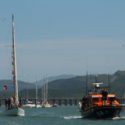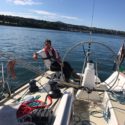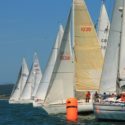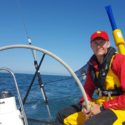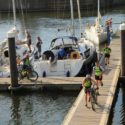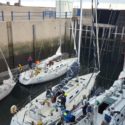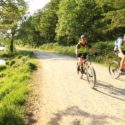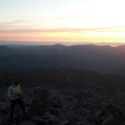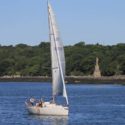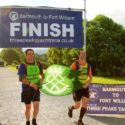It was to the beat of Welsh drums that the RNLI Lifeboat led Ajax and 13 other boats out of the harbour to the start line of the Three Peaks Yacht Race, while several hundred spectators watched the spectacle from across the broad Barmouth sands.
The Three Peaks is the original adventure race, and 17 June 2017 marked its 40th anniversary. It involves 400 nautical miles of sailing through some of the trickiest waters in Europe, and three land sections tackling the highest mountains in Wales, England, and Scotland, with 38 miles of cycling and 56 miles of running. It is all completed with a crew of only five: it is not a race to be taken lightly – thorough preparation is vital.
EX YEOMAN AMPHIBIAN – the Royal Yeomanry-led, Royal Armoured Corps campaign, which we christened Team AJAX after our boat, had been planned for eight months. We ensured new sails were bent on, brought the yacht and her crew safely to mid Wales, and finally saw her fully victualled and race-ready. The crew was drawn predominantly from the Royal Yeomanry – Lt Alexander Shaw (mate), Lt Alastair Coombe, and Tpr E – together with 2Lt Arthur Fearnall of the Queen’s Own Yeomanry and our skipper (and RACYC boatswain) Cpl Matt Cattell of the Royal Lancers. Our indomitable shore crew consisted of Cpl Chris Ladbrook RY and Pte Faye Watson RAMC. The skipper and mate ran the sailing, while the other three were mountaineers and marathon runners – only one of whom had any sailing experience.
The fastest teams usually have two specialist fell runners, and three experienced sailors – these are the racing snakes and sea-dogs who stick to their trades, and tend to win line honours and the overall handicap trophy. However, the Tilman Cup, named after the founder of the race, is awarded to the first team to cross the line having put a minimum of four out of the five crew on top of a hill. Winning this trophy was our main effort; our intent was to ensure the whole team summited at least one of the peaks. Military teams traditionally do well as it plays to our strengths, but nevertheless for the runners, the sailing was to be a baptism of fire, and vice versa.
We had a solid start – Lt Coombe commented that “after an hour of learning the ropes we assembled for the start and in an excellent manoeuvre crossed the line first!” Ajax is a fast boat: we were up with the leading pack for the first hours as we threaded our way between the mainland shore and the rock of Carreg Ddu, bore off the wind and rocketed up to Caernarfon in a brisk southwesterly breeze.
Three miles off Caernarfon there is a bar (a mobile subaqueous sand dune), which is often described as “the most dangerous place on the Welsh coast”; as we approached we saw one of the leading boats misjudge it, and go hard aground. We saw they had gone the wrong side of an unlit channel mark, so pressed on.
Lt Coombe and Tpr E were finalising their kit for the Snowdon leg down below as the depth gauge suddenly hit 0.0m and we suffered the same fate. Either the bar or the buoy had moved, or the high pressure rendered our tidal calculations inaccurate. All hands were called on deck and we managed to anchor in bouncy conditions to avoid drifting onto our competitor in the dusk. The tide lifted them off shortly afterwards but the position of our anchor in a shallow patch meant we were unable to raise it for another hour and a half – during which time most of the fleet overtook us and (despite our efforts to warn them) two other boats grounded themselves within metres of us. Now dark, their rigs were swinging uncomfortably close to ours, and there was nothing to be done but wait. Several, tense minutes later we fended one off by hand as she was lifted free of the bar by a wave. It was not an easy evening for the experienced crew, for those on board who were twelve hours into their sailing career it was more difficult; the youngest member of the team said afterwards that he had volunteered because he had never felt comfortable around water.
He certainly felt comfortable on land: within seven hours, the runners had leapt off the boat, run 25 miles through the night in glorious, clear conditions, climbed, summited at dawn and descended Snowdon (1,085m) and despite a suspected stress-fracture in a foot, rejoined the crew shortly after dawn ready to tackle the thorny navigation of the Menai Straits. It was monumental effort, and it was here that our brilliant shore team came into their own – providing food, water and morale in spades.
Our evening’s activities meant that we passed through the Straits on the tide behind the leaders, at low-water slack – this meant that we had less tidal flow, but needed to be more precise in our navigation to avoid the numerous hazards. To the relief of all, we passed through unremarkably, with a fair tide and a gentle breeze on our tail. As we cleared the Straits and headed into the Irish Sea we overtook one crew that had run aground, and two others who were in slower boats than us. The efforts of the runners had ensured we were back in the fray; spirits were high.
The sail that followed, from Anglesea to Whitehaven in Cumbria, provided rather a different challenge – patchy, light wind, and often none at all. To the horror of the sailors, the oars were deployed whenever the sails struggled to move us at less than two knots, which was often. However, with twenty-four hours at sea, and less complex navigation required, we were able to get into more of a watch system and snatch some sleep for the first time.
The sleep was useful. We had made up a lot of ground on the leaders, and managed to get through the Whitehaven lock on the same tide as four of the first five boats – it was all to play for. Our Scafell runners Lt Shaw and 2Lt Fearnall needed to be as fresh as possible. The running distance, a mere 13 miles, is not the issue: it’s the steepness and the overall distance; including the cycle it comes to 51 miles, with 1,878m of elevation gain and loss, almost all after the bike section. Framing was key: we never thought of the leg in terms of distance, but rather elevation, although it is always a surprise to remember that there is only one thing harder than the uphill: the bone-jarring downhill. Yet again – when we stumbled in the Wasdale Head Inn at the foot of Scafell – entirely cramped from the thighs down – the shore team gave us the boost we desperately needed, and we managed a time of nine and a half hours.
That meant we were out of the Whitehaven lock on the same tide as three of our closest competitors, and essentially had another race start in the strongest breeze we had yet faced. The runners fell asleep almost immediately, and we had 230 nautical miles ahead of us to sail (and row!). Now we were out in the open sea we were able to get the non-sailors on the helm more – the learning curve was steep, but they picked it up quickly.
At times we moved extremely quickly too – 11 knots around the Mull of Kintyre, and 12 as we passed through the Sound of Islay – with Tpr E (under the skipper’s watchful eye!) steering apace. At that point we split from the rest of the fleet – we judged it best to ensure we were through the tide gate between Islay and Jura rather than risk getting stuck at the notorious Corryvreckan and Sound of Luing. It was a tactical gamble that nearly paid dividends (best case we would romp to victory, worst case we would lose one place, which we eventually did), but in light southwesterlies we estimated it to be much the safest option as it allowed us to ‘bank’ our position.
Indeed, the breeze died as we passed through the Great Race – an area of tidal turbulence with steep waves and fast whirlpools – and we ghosted up ever closer to Fort William. As we came up South of Lismore we were briefly stuck in a windless, biblical downpour, with plenty of forked lightning. The nearest bolt struck much closer than a mile away – so we limited numbers on deck, put the kettle on, and had a tea cake. Conditions were variable for the final thirty miles: oars, spinnakers, and 180° wind shifts constantly challenging the crew.
Ben Nevis was the final hurdle, and Cpl Cattell and Lt Coombe (three days later, and therefore fully recovered from his Snowdon leg) stepped up fantastically after some incredibly demanding sailing to ensure the whole crew ran at least one hill. Having never run more than a half marathon before, the skipper told us felt it in his legs a bit, but was sustained throughout by Jelly Babies, sensible pacing, and a resolute shore crew. Passing the other runners en route down, all had time for smiles and handshakes – the camaraderie among both runners and sailors was phenomenal.
We must note the efforts of our competitors Pip Hare and Charles Hill in particular: they completed the whole race on their own as a pair – the first time the race had ever been ‘doublehanded’. It was an awesome effort and they managed to finish second overall. Every time we thought we were suffering we just thought of them and it kept us going! 18 hard miles later, we came through the finish line in bright sunlight, bearing the Royal Yeomanry flag, to the rapturous cheers of a small but committed crowd.
Finishing 5th over the line and 6th on handicap, with a novice crew and at the first attempt, was an immensely satisfying result. Later that morning the race committee confirmed that we had achieved our main aim – we had won the Tilman Cup. We were also awarded the Light Infantry Bugle (for the fastest services team), and the Colin Prescott Walker Trophy for the youngest team to finish. We also won the slightly inglorious Kamminga Kloggs – for the slowest aggregate land time of those who finished!
We must thank The Ulysses Trust, General Dynamics Land Systems UK, the Royal Armoured Corps Yacht Club, and the Royal Yeomanry for so generously backing our campaign, and the race committee for running it all so well. Just getting to the start line was immeasurably interesting, difficult, and complex – to say nothing of the race itself. No single part can be underestimated, on land or at sea, but the whole forms a real challenge. Like those who came to Barmouth to see us off – we must bang the drum for more services entries next year.
Lt Alexander Shaw, RY

